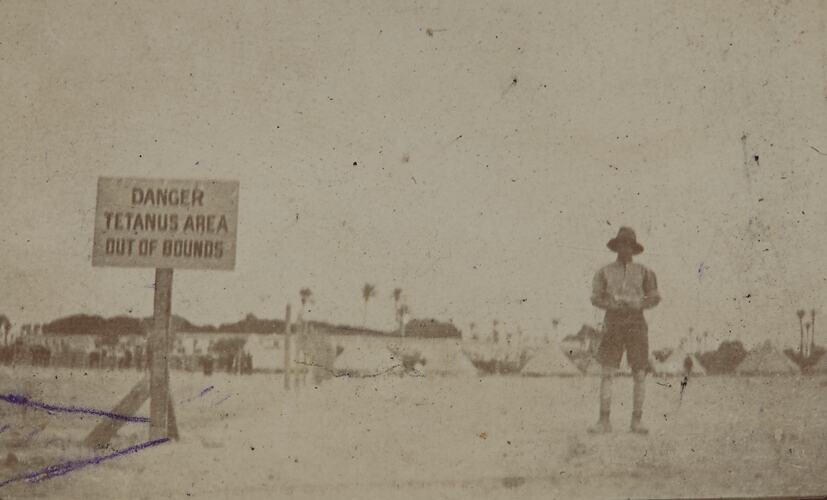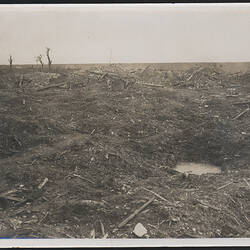Summary
Photograph of a man standing near a sign inscribed 'DANGER TETNUS AREA OUT OF BOUNDS'. It appears to have been taken in an army camp in Egypt, support by the presence of palms in the distance and the provenance of the album in which it was acquired.
Leo Van Bergen estimates that tetanus killed of half of those who contracted it ('Military Medicine', Cambridge History of the First World War, vol.III, p.300); all sufferes experienced terrible agony. Interestingly, Duncan Stout suggests in War Surgery & Medicine that the lack of recorded tetanus cases in Egypt incidates a low incidence during World War I (chapter 6, p.133). Official medical historian A.G. Butler reported that in France in 1915 there were 14 cases of tetanus, with 10 deaths, in the AIF, 'but there were probably more'. Anti-tetanic serum was administered in the field, at first only for 'dirty wounds' but after September 1915 all wounded, including those at Gallipoli, received the serum (Chapter XXI, p.467), which greatly reduced the incidence of tetanus.
From a photograph album created by Sergeant John Lord documenting his time in Egypt during World War I. The album was created in a lined notebook/diary type book and John Lord completely filled the album with photographs. All of the photographs are numbered and in pencil he has written captions around many of the photographs. A few of the early photographs are dated 1915. Many of the photographs depict camps, local people, street scenes, fellow soldiers at rest, horses, ambulances, hospitals and camels.
Description of Content
A man wearing shorts is standing near a sign inscribed 'DANGER TETNUS AREA OUT OF BOUNDS'. Palms are visible in the distance.
Physical Description
Black and white photographic print.
More Information
-
Collection Names
Military Memorabilia Collection, John Lord Collection, Returned and Services League (RSL) Collection
-
Collecting Areas
-
Acquisition Information
Donation from J. Lord, 24 Feb 1986
-
Place & Date Depicted
-
Photographer (Probable)
-
Format
Photograph, Black & White
-
Classification
-
Category
-
Discipline
-
Type of item
-
References
T. Duncan M. Stout, 1954. War Surgery & Medicine, Victoria University of Wellington. Leo Van Bergen, 'Military Medicine', in Jay Winter (ed.), 2014. Cambridge History of the First World War, vol.III, Civil Society, pp.287-309.
-
Keywords
Signs, Wars & Conflicts, World War I, 1914-1918, Tetanus, Army Camps


